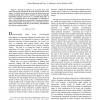Free Online Productivity Tools
i2Speak
i2Symbol
i2OCR
iTex2Img
iWeb2Print
iWeb2Shot
i2Type
iPdf2Split
iPdf2Merge
i2Bopomofo
i2Arabic
i2Style
i2Image
i2PDF
iLatex2Rtf
Sci2ools
103
click to vote
SMC
2007
IEEE
2007
IEEE
Decision-making under severe uncertainty for autonomous mobile robots
— The field of robotics is on a growth curve, with most of the growth expected in the areas of personal and service robots. As robots become more prevalent in chaotic home and industrial settings, they will be required to make increasingly independent decisions about how to accomplish their tasks. A key to accomplishing this is the development of techniques to allow robots to handle severe uncertainty. This paper introduces the use of Information Gap Theory as a way to enable robots to make robust decisions in the face of uncertainty, and illustrates this with an example problem.
Related Content
| Added | 04 Jun 2010 |
| Updated | 04 Jun 2010 |
| Type | Conference |
| Year | 2007 |
| Where | SMC |
| Authors | Daniel Berleant, Gary T. Anderson |
Comments (0)

